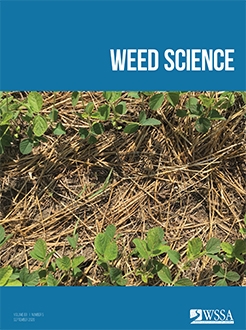Intensified cover-cropping practices are increasingly viewed as a herbicide-resistance management tool but clear distinction between reactive and proactive resistance management performance targets is needed. We evaluated two proactive performance targets for integrating cover-cropping tactics, including (1) facilitation of reduced herbicide inputs and (2) reduced herbicide selection pressure. We conducted corn (Zea mays L.) and soybean [Glycine max (L.) Merr.] field experiments in Pennsylvania and Delaware using synthetic weed seedbanks of horseweed [Conyza canadensis (L.) Cronquist] and smooth pigweed (Amaranthus hybridus L.) to assess winter and summer annual population dynamics, respectively. The effect of alternative cover crops was evaluated across a range of herbicide inputs. Cover crop biomass production ranged from 2,000 to 8,500 kg ha-1 in corn and 3,000 to 5,500 kg ha-1 in soybean. Experimental results demonstrated that herbicide-based tactics were the primary drivers of total weed biomass production, with cover-cropping tactics providing an additive weed-suppression benefit. Substitution of cover crops for PRE or POST herbicide programs did not reduce total weed control levels or cash crop yields but did result in lower net returns due to higher input costs. Cover-cropping tactics significantly reduced C. canadensis populations in three of four cover crop treatments and decreased the number of large rosettes (>7.6-cm diameter) at the time of preplant herbicide exposure. Substitution of cover crops for PRE herbicides resulted in increased selection pressure on POST herbicides, but reduced the number of large individuals (>10 cm) at POST applications. Collectively, our findings suggest that cover crops can reduce the intensity of selection pressure on POST herbicides, but the magnitude of the effect varies based on weed life-history traits. Additional work is needed to describe proactive resistance management concepts and performance targets for integrating cover crops so producers can apply these concepts in site-specific, within-field management practices.
How to translate text using browser tools
16 June 2020
Alternative Performance Targets for Integrating Cover Crops as a Proactive Herbicide-Resistance Management Tool
Jess M. Bunchek,
John M. Wallace,
William S. Curran,
David A. Mortensen,
Mark J. VanGessel,
Barbara A. Scott

Weed Science
Vol. 68 • No. 5
September 2020
Vol. 68 • No. 5
September 2020
Erigeron canadensis
integrated weed management
no-till
population dynamics





